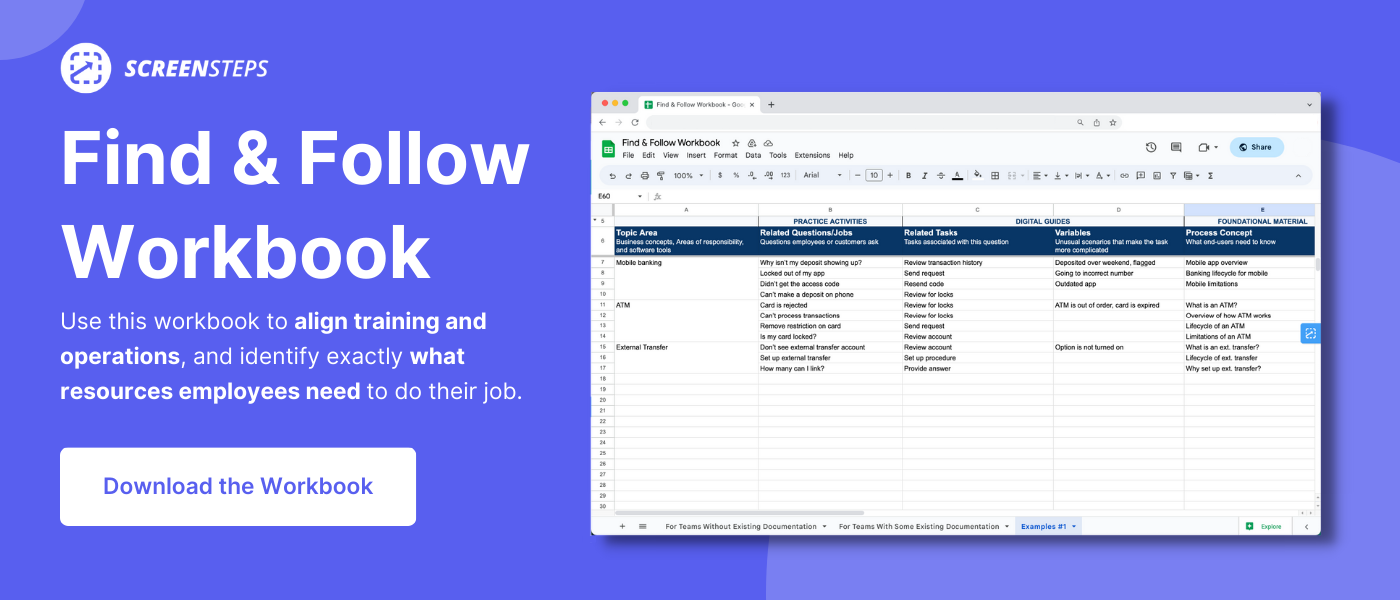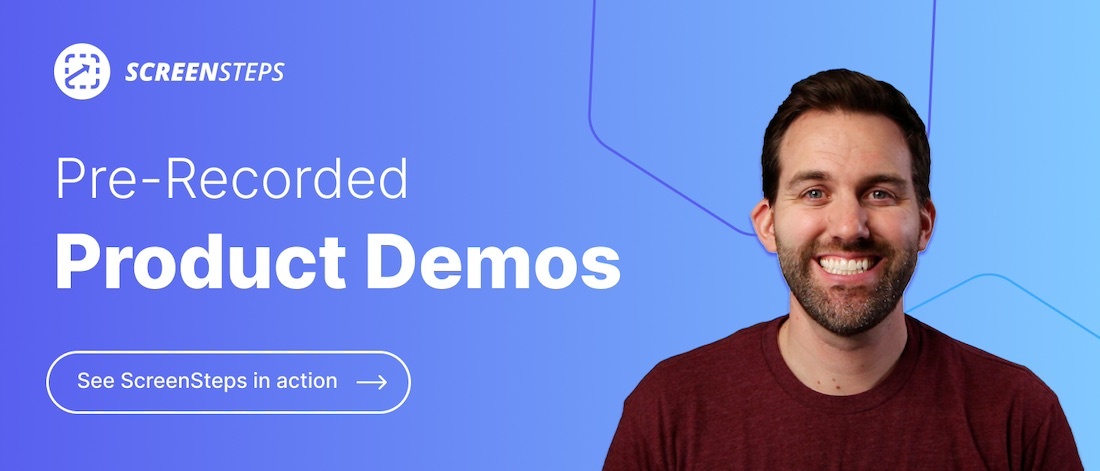11 Tips for Designing Knowledge Base Articles That Empower Call Center Agents
When call centers go through turnover, expansion, or bring on a BPO, they maintain metrics by burning out their supervisors.
The following story plays out:
- Agents get calls that they can't completely handle on their own
- Supervisors jump on the call to help out
- Supervisors spend all of their time hopping on calls instead of developing agents and moving the call center in a strategic direction that benefits the business
Sound familiar? If it does, I’m sure your call center supervisors have felt exhausted, frustrated, and even considered quitting a time or two.
You don’t want to lose your supervisors or wear them out. So, what are you supposed to do?
As the co-founder of ScreenSteps — a knowledge base software company that helps call centers enable their agents — I’ve seen this scenario play out over and over again.
What I’ve found that helps the most is turning agents into self-reliant learners. One powerful way to do that is by creating clear knowledge base articles that enable your agents to perform any procedure on their own.
Use these 11 tips to design knowledge base guides that let ANY agent handle ANY call, of ANY complexity, WITHOUT putting the customer on hold or making a mistake.
1. Host a content planning workshop
A content planning workshop helps you evaluate what content you have in your knowledge base as well as identify job aids that may be missing from your knowledge base.
In a content planning workshop, you gather your company leaders and experts to discuss what guides need to be included in your knowledge base.
The goal is to fill your knowledge base with call flows, policies, standard operating procedures (SOPs), and other job aids. That way, your call center agents will be able to access your guides when they need them on calls.
Want to run a content planning workshop for your call center? Follow these seven tips on how to run a content planning workshop and download the free Find & Follow Workbook.
2. Design digital guides that stand alone (and test them)
Your knowledge base articles should be able to stand alone. By that, I mean that your digital guides should be able to walk your call center agents through a procedure from step one until the end of the call.
Your agents should be able to complete a task by using your guides. If your agents need to stop to ask a supervisor or neighbor a question, then your digital guides can’t stand on their own.
Before you launch a new knowledge base article, test it. Have call center agents with various levels of experience test your procedural guides. If they get stuck at different points, make edits and try it again. Your agents should be able to seamlessly complete a procedure using your guide.
3. Put a feedback mechanism in place
How do your end-users send you feedback? Your call center agents use your knowledge base articles every day on the job. They will be the first to notice if something is wrong, missing, or confusing in a knowledge base.
Provide an easy way for your agents to send your content authors feedback on articles. Many knowledge base software companies have tools that allow you to write comments or send messages within the knowledge base or even on articles.
If you don’t have a knowledge base feedback function, you can create an email or chat message channel for end-users to send feedback.
However, I recommend getting a knowledge base that has feedback functions within its software. It streamlines the feedback process and makes communicating changes easier.
4. Include visuals
Don’t just tell agents what they need to do — show them. When call center agents are on a call, they are handling multiple tasks at once. They are talking to a caller, taking notes, searching your knowledge base for answers, etc.
Including screenshots and other visual aids in your knowledge base articles helps your agents know where to click on a page. They don’t need to scan your website guessing what the next steps are.
Your screenshots are even more helpful if you add annotations to them.
🔎 Watch Related: 6 Tips for Adding Screenshots to Your Job Aids and Procedures [Video]
5. For complex scenarios: Make your guides replicate conversations
When it comes to troubleshooting, your SOPs can get complex. There are a lot of decisions and different outcomes in the procedure. That can make it difficult for your call center agents to follow the guides.
Instead of writing step-by-step instructions, write your procedures as conversations. These conversational guides are referred to as call flows or call center scripts.
With a call flow, you use a question-and-answer format. Your agents ask the caller a question. The caller’s answer determines the next step.
A call flow is written to optimize the movement of a call. That means it is written to eliminate options upfront so that the call can be resolved quicker.
6. Analyze and optimize your search results
Most knowledge base software offers some analytics. However, the different analytic offerings are different according to the company.
If offered, review what words your call center agents are using to search the knowledge base. Are they finding what they need with the terms they type in?
Use the terms your call center agents type into your knowledge base search bar to optimize your search results. Add those terms as keywords to articles so it is easier for agents to find the articles they need.
7. Require your agents to use the guides on every call (even the experienced reps)
EVERY agent needs to use your knowledge base guides on EVERY call. Why? Because your knowledge base is there to help your agents when they get stuck AND to prevent agents from making mistakes.
Even tenured agents forget steps to procedures every once in a while. It’s human nature. Your mind can blank at the most inconvenient times.
More importantly, your agents need to use your knowledge base articles on every call because your policies, processes, and procedures are always changing.
If all of your agents are using your guides on your calls, all you need to do when a change happens is update your guides. Your agents automatically see the changes in the guide and instantly adapt to the new procedure.
When all your agents follow your guides on every call, you can be more agile as a call center.
How to encourage tenured agents to use your guides
Once your agents have a grasp on their job, they may be tempted to stop using your guides.
You can encourage your agents to continue using your guides by making your guides flexible. To do this, your knowledge base software needs to have interactive features.
For example, you could have a checklist for a call. A tenured agent would just need to skim and check off each step.
A new agent that is still learning could use the same checklist, but they would need more details on how to do each checkpoint. Add expandable sections to your checklist so new agents can expand it for further instructions.
8. Identify what new reps should be able to do after training
Are your knowledge base articles abstract ideas or concepts? Or are they actionable instructions?
One common mistake I see call centers make is they focus their training on what they want their call center agents to know. However, your procedural guides are meant to help your agents DO something.
Before you design your knowledge base articles, identify what you need your agents to be able to do. Do they need to be able to complete a credit card transaction over the phone? Do they need to be able to place an order to exchange a router that isn’t working?
Then, as you design the guides, think about what instructions will help your agents complete the task.
9. Teach reps how to use your guides during training
You shouldn’t be creating separate training guides from your knowledge base articles. Your training guides are your knowledge base articles.
Teach your reps how to read your guides. Do you use italics for things your agents need to say? Do you use a specific color to indicate warnings?
Show them the knowledge base articles and teach them how to follow the directions on the guides.
10. Provide foundational material during training
Foundational material is different from procedures your call center agents will use on a call. The foundational materials you want to provide during training contain background information.
This is the background information your call center agents need to learn and know in order to use your procedural guides on the job. The foundational materials help train your agents on:
- What software tools they will use
- What types of people they will interact with
- What the business does
- What customers generally want from the business
11. Run practice scenarios during training
Have your reps practice real-call scenarios during training with the same guides they will use on the call center floor. This training approach is called scenario-based training. With scenario-based training, your agents role-play real situations they will encounter on calls.
This will help familiarize them with the resources they have. They will better be able to follow the guides. And they will know what to do once they are working independently.
Use these scenario-based training examples to practice different call center situations during your call center training.
Take the pressure off your supervisors with an agile knowledge base
When supervisors have to assist their call center agents too often, it leads to:
- Longer training time
- Longer handle time
- More mistakes
- Higher attrition rates
- Stressed out and overworked supervisors!
The problem is that supervisors don't have the tools to create resources that turn customer-facing employees into self-reliant learners who don't need assistance from their supervisors.
That’s where a knowledge base comes in. A knowledge base helps call center reps to become more self-reliant, avoid mistakes, and improve the customer experience.
With a ScreenSteps knowledge base, we’ve created tools that help your call center agents be efficient and effective. Agents don’t need to put a caller on hold because they can find the right article in as few as two clicks.
Plus, authoring and updating articles is fast and easy. You can create guides in up to 75% less time.
Ready to design a knowledge base that creates more self-reliant call center agents?
Watch the pre-recorded demo videos for ScreenSteps. The videos will show you the tools that could help make your call center more efficient, effective, and agile.




